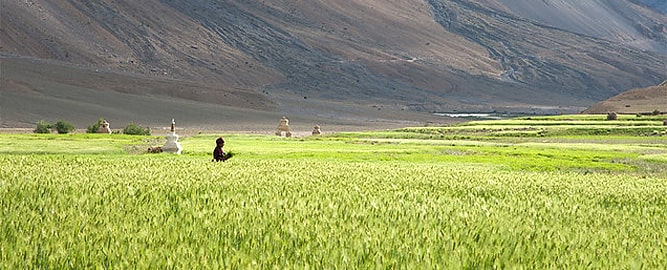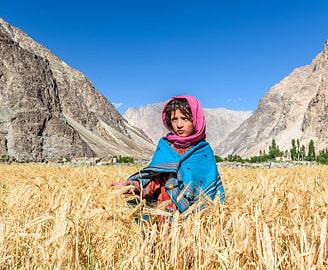Ladakh is a high-altitude cold desert in the rain shadow of the Himalayas with 300 days of sunshine and only 100 millimetres of precipitation annually. Even though it hardly rains in Ladakh, storm and localized heavy downpour can cause flash floods and mudslides. In Leh, at 3,500 metres altitude, the average temperature reaches 25°C during the day in summer while it dips to -15°C at night in winter. It can be significantly colder at higher altitude where night-time temperatures can drop below zero even in summer. Always take warm clothing and protect yourself from the strong sun when travelling in Ladakh.


Temperature and precipitation in Leh-Ladakh
| Month | Temperature Max / Min (°C) | Temperature Max / Min (°F) | Precipitation | Rain days |
|---|---|---|---|---|
| January | -3 / -15 | 27 / 5 | 9 mm (0.4 in) | 1.3 days |
| February | -1 / -12 | 30 / 10 | 8 mm (0.3 in) | 1.1 days |
| March | 6 / -6 | 43 / 21 | 11 mm (0.4 in) | 1.3 days |
| April | 12 / -1 | 54 / 30 | 9 mm (0.4 in) | 1.0 days |
| May | 17 / 3 | 63 / 37 | 9 mm (0.4 in) | 1.1 days |
| June | 21 / 7 | 70 / 45 | 4 mm (0.2 in) | 0.4 days |
| July | 25 / 10 | 77 / 50 | 15 mm (0.6 in) | 2.1 days |
| August | 24 / 9 | 75 / 48 | 15 mm (0.6 in) | 1.9 days |
| September | 21 / 5 | 70 / 41 | 9 mm (0.4 in) | 1.2 days |
| October | 14 / -1 | 57 / 30 | 8 mm (0.3 in) | 0.4 days |
| November | 7 / -7 | 45 / 19 | 4 mm (0.2 in) | 0.5 days |
| December | 1 / -11 | 34 / 12 | 5 mm (0.2 in) | 0.7 days |
What is the coldest month in Leh-Ladakh?
The coldest month is January, with an average temperature of -3°C (27°F) during the day and an average temperature of -15°C (5°F) during the night. As the weather is always dry and sunny, it does not feel as cold as one would expect and travelling in Ladakh at this time of the year is a wonderful experience.
How many days per year does it rain in Leh-Ladakh?
Ladakh is a high-altitude desert, there are only 13 rainfall days per year and 106 mm (4.2 in) of accumulated precipitation. This is the reason why water is a very precious resource and saving water when travelling in Ladakh is important.
What is the driest month in Leh-Ladakh?
The driest months are June and October, with less than half day of rainfall per month and 4 mm (0.2 in) of precipitation.
What is the warmest month in Leh-Ladakh?
The warmest month is July, with an average temperature of 25°C (77°F) during the day and an average temperature of 10°C (50°F) during the night. Average temperatures in August are just 1°C (2°F) lower.
What is the wettest month in Leh-Ladakh?
The wettest months are July and August. However, with only 2 days of rainfall per month and 15 mm (0.6 in) of precipitation, these months are still very dry. For comparison, the average precipitation during this period in Delhi is 17 times higher with 250 mm (9.8 in) per month.
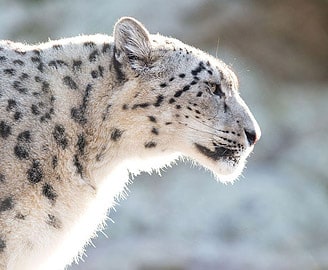
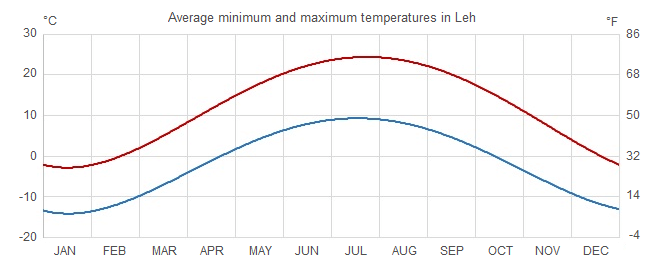
| Date | Sunrise | Sunset | Day length |
|---|---|---|---|
| January 15th | 07:25 | 17:32 | 10:06 |
| February 15th | 07:05 | 18:02 | 10:57 |
| March 15th | 06:30 | 18:27 | 11:57 |
| April 15th | 05:48 | 18:51 | 13:02 |
| May 15th | 05:17 | 19:14 | 13:56 |
| June 15th | 05:07 | 19:32 | 14:25 |
| July 15th | 05:19 | 19:31 | 14:12 |
| August 15th | 05:41 | 19:06 | 13:25 |
| September 15th | 06:02 | 18:26 | 12:23 |
| October 15th | 06:24 | 17:45 | 11:20 |
| November 15th | 06:52 | 17:15 | 10:23 |
| December 15th | 07:18 | 17:11 | 09:53 |
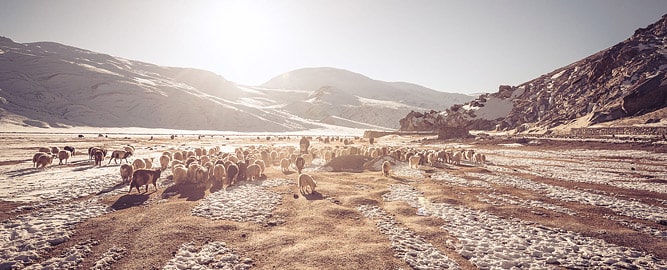
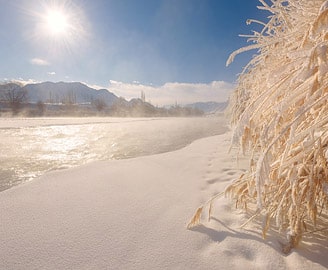
7-day weather forecast for Leh-Ladakh
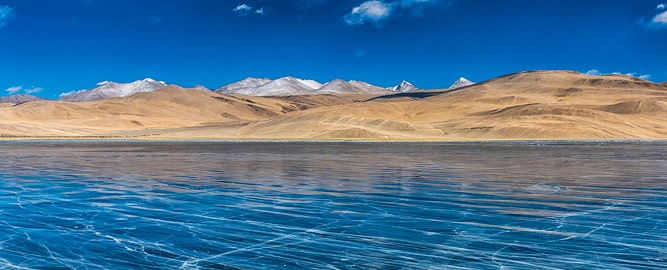
Best season to visit Leh-Ladakh
The most popular time for visiting Ladakh is from May to end of September when temperatures are warmer. But there really is no bad time to visit Ladakh, as the weather is always sunny and each season offers its own enchanting sights and experiences. Ladakh lies in the rain shadow of the Himalayas so monsoon rain clouds are blocked and the climate is always very dry.
Summer is the high season for tourism in Ladakh and this is the best time for those who want to do trekking. The shoulder months (April and October-November) combines the advantages of both high and low-season travel. Temperatures are still pleasant (between 10 and 15°C during the day) and there are fewer tourists which means that you can enjoy the famous cultural and natural sites without the crowd. Winter season has its own charms and beauty as you can trek on the frozen Zanskar river and spot the elusive snow leopard which comes down to the valley to look for food and mating partners.
Ladakh can be reached all year round by flight from Delhi. The Leh-Manali highway is normally open from June to October while the Leh-Srinagar highway is usually open from April to November. Roads within Ladakh remain open in winter.
Winter in Ladakh (January, February, March)
Visiting Ladakh in winter is not as crazy as it sounds. January is the coldest month with an average temperature in Leh of -3°C during the day and -15°C during the night. Despite the cold temperatures, it is well worth considering a trip to Ladakh in winter to see the mighty Himalayan landscapes covered with snow and experience the thrill of walking on a frozen lake.
The internal roads within Ladakh remain open in winter so it is possible to visit places like Nubra valley, Pangong lake, Tso Moriri lake, Lamayuru, Sham valley and Kargil. It is also important to remember that in case of heavy snowfall the passes such as Chang La and Khardung La can be closed for a day or two so you should always include extra days as contingency in case of bad weather when you plan a trip to Ladakh in winter. Flights can sometimes be delayed due to heavy snow. Accommodations are limited and most of the restaurants are closed in winter, but don’t worry, you will always find a place to stay and eat in every village.
If you visit Ladakh in winter, you will have the opportunity to attend one of the major monastery festivals such as Spituk Gustor, Guru Tsechu (in Stok) and Nagrang (in Matho). Winter is also the wedding season in Ladakh as this is the only time when people are not busy in the fields. You will have the chance to try winter sports such as ice skating, ice hockey and ice climbing.
From mid-January to mid-March, this is time for the well-known Chadar trek on the frozen Zanskar river. It is the also the time when the snow leopard descends to the valley in search of food, a photographer and wildlife enthusiast’s dream come true.
Spring in Ladakh (April, May, June)
Spring is the time when Ladakh’s famous apricot trees burst into bloom and the valleys come alive with beautiful pink flowers. The blooming time is usually from end of March to mid-April but it varies with altitude.
The temperatures are pleasant, ranging between 15 and 20°C during the day. Occasional snowfall can still occur in April but only at higher altitude (above 4,000 or 4,500 metres).
The high mountain passes of Khardung La and Chang La are still covered with a thick layer of snow and driving through them is an unforgettable experience. The Leh-Srinagar road opens in April while the Leh-Manali road opens in early June. In late April, the frozen Pangong and Tso Moriri lakes start melting and patches of blue-hued water appear with the rising temperatures. This is one of Mother Nature's best spectacles.
In spring, almost all hotels, restaurants and local business are open and getting ready for the upcoming season.

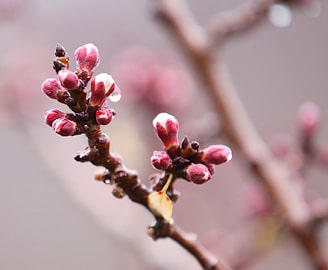
Summer in Ladakh (July, August, September)
The main tourist season in Ladakh is during the summer when the average temperatures are around 25°C during the day and 10°C during the night. The days are blessed with a lot of sunshine so you need to regularly apply sunscreen, wear a hat and proper sunglasses.
From the beginning of July to the end of August, it is the peak tourist season and Ladakh is buzzing with travellers visiting the region. During this time, the flights from/to Delhi can become expensive so it is recommended to book well in advance. Another option is to fly from Delhi to Leh and leave Ladakh by road via Manali or Srinagar.
Summer is the best time for those who want to do trekking. There are many trekking options in Ladakh to discover remote and isolated valleys. Rafting on the Zanskar and Indus rivers is another popular activity in summer in Ladakh. Many monastery festivals take place in summer. This is the opportunity to watch the colourful mask dances which are performed by monks in the monastery courtyard. Hemis Tsechu is the most famous festival in Ladakh.
September is another great month to visit Ladakh with clear sky and fewer tourists than in July and August. September is the harvest time in Ladakh, there is a lot of activity in villages and farmers are busy working in the fields. The Ladakh festival celebrated in Leh marks the harvest season. During this festival, you can see dancing, singing, traditional music and people wearing colourful costumes.
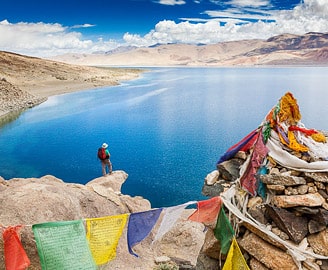
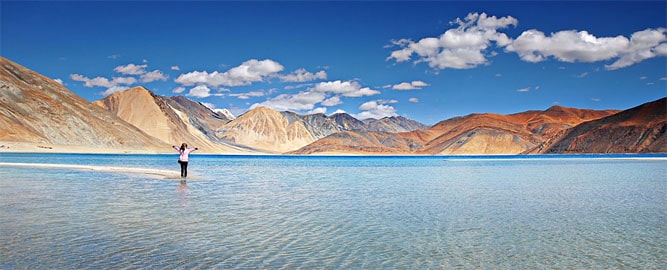
Autumn in Ladakh (October, November, December)
The month of October is a good time to visit Ladakh. It is the end of tourist season and there are fewer visitors to experience peaceful moments and enjoy the serenity of the places. The temperatures in October are cooler than in summer but still very pleasant, around 15°C in daytime.
The month of November is colder but is still fine to travel. Temperatures remain fairly mild but the occasional snow flurries can occur. By this time many hotels and restaurants start closing down in Leh and locals gather food and other important items in preparation for the coming winter.
